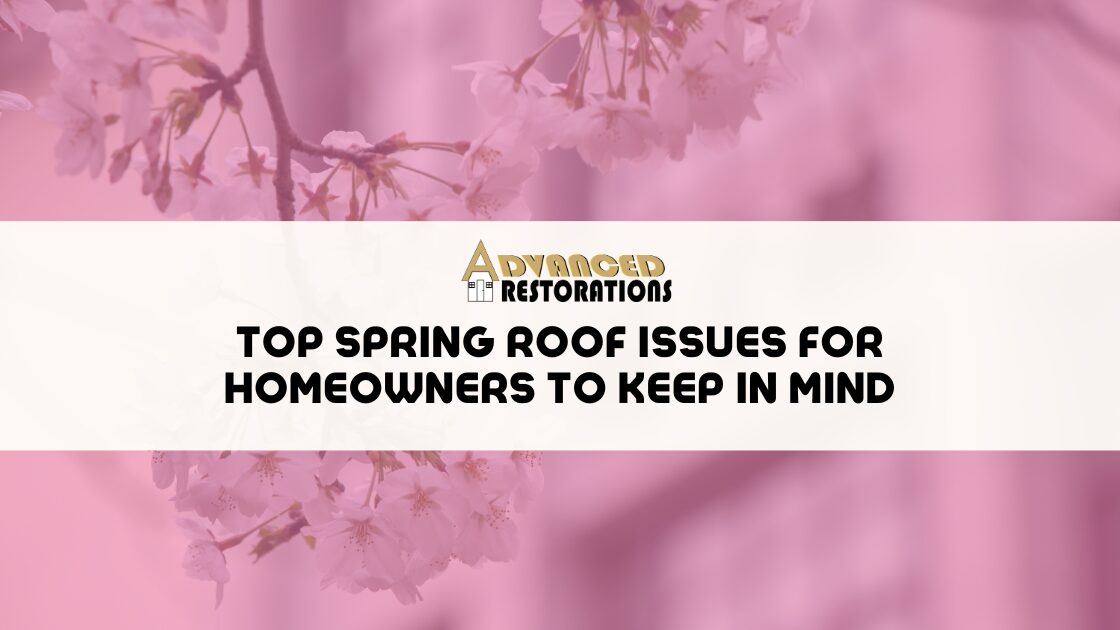
Top Spring Roof Issues for Homeowners to Keep in Mind
Now that winter is over and the weather is warming up, the last thing a homeowner wants is roof issues to deal with. As the days get longer, it is a vital time to ensure roofing systems are healthy as they recover from the rough winter conditions. Additionally, with the nicer days comes spring storms potentially full of rain and hail, as we have all seen this past month. Keep on top of your roofing system’s health by looking out for these top dangers in the Spring!
1. Active Leaks
This may seem obvious, but many roof leaks start small and often go unnoticed until there is a larger issue. Contrary to what one might think, it is much easier to identify a potential leak from reviewing the interior of the home instead of the exterior. Start by taking a flashlight into the attic, shining the beam under the eaves of the home. Take note of any additional reflection you may see on the exposed beams, stains, discoloration, or streaks; these are potential signs of a leaky roof. Scheduling a roof inspection every few years or after a major hailstorm are great ways to stay proactive in avoiding catastrophic issues.
2. Trapped Moisture and Related Damage
Occasionally leaves, needles, and other debris can collect on rooftops before winter and remain trapped until the spring. This can create matted materials in the gutter system and on lower sloping rooftops, can trap moisture for extended periods of time. This, combined with the rough winds and ice from winter weather, can cause moisture damage. That damage won’t become as apparent until the spring rainstorms hit. That is why it is important to keep your rooftop cleared and inspected in the spring for any moisture issues before they become something much worse like a leak!
3. Insulation Issues
Going into spring after a winter full of extreme cold and ice storms, now is the time to make sure your home is properly insulated before the summer. Insulation issues can cause big headaches in the summer months – your home seems impossible to cool down and your energy bill is skyrocketing. If you have noticed any issues like drafts in different rooms or pests entering the home more frequently, these could be initial signs that more insulation is needed. To learn more about insulation issues, visit our recent article for more tips on identifying issues before it becomes a real problem!
4. Failed Sealants
Many building materials used on a roofing system are not designed to contract in the cold and expand in the heat. Over time that contraction and expansion can cause problems for those materials, particularly as the roofing system ages. Over time, sealants, which protect rooftop flashing, can crack and warp. Eventually this will cause gaps to form. The separation in the sealant can allow water to flow in causing damage to not only the flashing, but any sheathing or masonry underneath. Flashings around chimneys are most often exposed to this issue. Identifying potential problems with sealants requires closer examination, which is why we advise having a professional provide this inspection on older roofs in the spring.
5. Shingle Issues
As we mentioned before, materials will contract and expand over time, which can be an issue for older shingles. This issue will more often show itself during volatile winters with extreme colds, followed by unseasonable warm fronts. The contraction and expansion from such drastic temperature changes can cause the shingles to crack, split, or warp, especially if they were improperly installed on the roof. It is also important to be on the lookout for missing shingles potentially caused from high winds. It is also a great idea to monitor you gutter runoff for large amounts granular loss. Granular loss in the gutters is often a sign of older shingles but can also be an indication of weather-related damage.
6. Pest Issues
As animals and insects are recovering from hibernation, they will be on the lookout for more food and finding places to create nests before the summer. One of the primary entry points for your home can be found in your attic and throughout your roofing system. Be on the lookout for pests like ants, squirrels, racoons, termites, birds, and other creatures that can damage your roof, chimney, and eaves. Beyond attacking your roofing system, these pests will use any opening they can find and will create a nest in many places they find. Ensure you have guards in place to protect any vulnerable parts of your roofing system.
We hope this article has helped you gain a better understanding of spring roofing system issues and how to identify them before they cause huge headaches down the road!
We dedicate ourselves to providing homeowners peace of mind by offering complimentary inspections. With years of contracting experience, we take pride in our ability to identify improperly installed roofing systems and prevent long term damage before it is too late! Contact us today to schedule a complimentary inspection!
